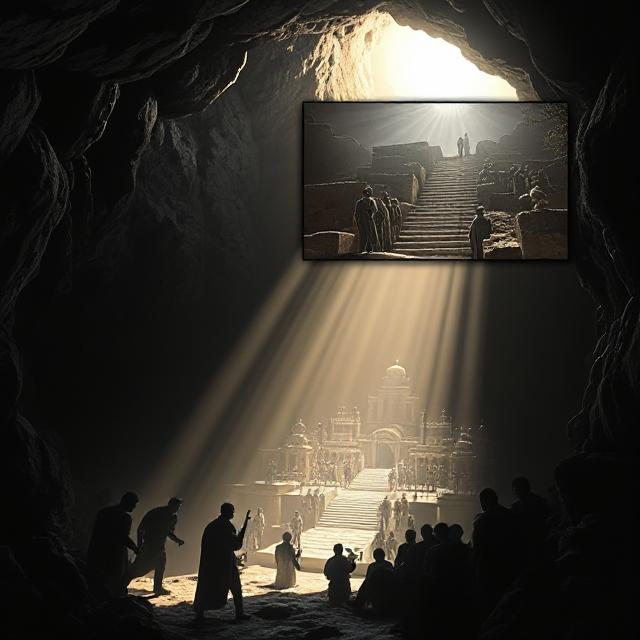
Table of Contents
Plato’s Legacy: Ideal Forms and Political Theory
Introduction: Why Plato Still Matters
Plato is often called the father of Western philosophy—and for good reason. As a student of Socrates and teacher of Aristotle, Plato sits at a pivotal moment in intellectual history. But what makes his legacy enduring isn’t just his placement in a famous trio.
It’s his philosophical daring—his attempt to describe what is most real, not by pointing to the world around us, but by reaching beyond it. It’s also his vision of political order, where justice is not just an ideal, but a structure that must be built with reason.
This post explores two pillars of Plato’s thought:
- His metaphysics of ideal forms, and
- His political theory, most famously outlined in The Republic.
I. The Theory of Forms: What Is Truly Real?
Plato’s theory of ideal forms (or simply forms) argues that the physical world we see is just a shadow of a higher, unchanging reality.
Core Idea:
Every object in the world is an imperfect copy of a perfect, immaterial form.
Examples:
- A beautiful painting partakes in the form of beauty.
- A just action reflects the form of justice.
- A circular object imitates the form of a circle—a mathematically perfect idea.
The Allegory of the Cave
In The Republic, Plato illustrates this with the Allegory of the Cave:
- Prisoners see only shadows on a wall.
- One escapes, sees the real world, and realizes the shadows are illusions.
- The sun—representing the form of the Good—illuminates true knowledge.
Lesson: True knowledge (episteme) is not derived from the senses (doxa), but from rational understanding of forms.
II. How Ideal Forms Shape Philosophy
Plato’s metaphysical vision introduced key philosophical distinctions:
- Appearance vs. Reality
- Opinion vs. Knowledge
- Material vs. Immaterial
He inspired:
- Rationalism: Knowledge comes from reason, not sense experience.
- Mathematics in metaphysics: Math becomes a gateway to understanding eternal truths.
- Philosophy of language: Words refer to general forms, not just particular things.
Even today, debates about universals vs. particulars, abstract objects, and essentialism bear Plato’s fingerprint.
III. Plato’s Political Philosophy: The Just Society
Plato didn’t stop at metaphysics. He asked: If the world of forms represents truth, how should society reflect it?
In The Republic, he outlines a political vision rooted in justice as a harmonized structure of different parts.
The Tripartite Soul and the Tripartite City
Plato divides the soul into:
- Reason – seeks truth
- Spirit – seeks honor
- Desire – seeks pleasure
Likewise, society has three classes:
- Rulers (Philosopher-Kings) – guided by reason
- Guardians (Warriors) – driven by spirit
- Producers (Workers/Farmers) – driven by desire
Justice occurs when each part performs its role without interfering in others—in both the individual and the state.
IV. The Philosopher-King: Rule by Wisdom
Plato famously argues that philosophers must rule—those who understand the forms, especially the form of the Good.
Why?
- They have no lust for power.
- They rule not for themselves but for the good of the city.
- They see beyond illusion to true order and virtue.
Plato was deeply skeptical of democracy, especially after it led to the execution of Socrates. For him, popular rule meant rule by opinion, not reason.
V. Criticisms of Plato’s Political Vision
While visionary, Plato’s political theory has drawn criticism:
| Critique | Response |
|---|---|
| Elitism: Rule by philosophers excludes the masses. | Plato argues only those with wisdom should govern, not those with ambition. |
| Authoritarianism: Strict class divisions and censorship. | He prioritizes harmony and truth over liberty. |
| Utopianism: The ideal city is unattainable. | Plato saw it as a model, not a blueprint. |
Despite flaws, The Republic shaped centuries of political thought—from Augustine’s City of God to Rawls’ theory of justice.
VI. Plato’s Influence Across Eras
Plato’s ideas have echoed for millennia:
- Early Christianity: The immaterial world of forms influenced Christian ideas of heaven and divine truth.
- Renaissance Neoplatonism: Thinkers like Marsilio Ficino revived Platonic metaphysics.
- Modern science: Mathematicians like Gödel were inspired by Platonic realism.
- Political theory: From utopianism to critiques of democracy, Plato’s Republic remains foundational.
Even in fiction, echoes of Plato abound—from The Matrix (a world of illusion) to dystopian political structures.
VII. TL;DR Summary
- Plato’s legacy lies in his dual pursuit of metaphysical truth and political order.
- His theory of forms teaches that true reality lies beyond the physical world.
- His political theory imagines a just society governed by reason and wisdom.
- Plato’s thought shaped everything from rationalism to education, theology, and civic governance.
Final Reflection: Why Plato Still Speaks to Us
Plato’s genius lies not just in what he argued, but in how he framed the philosophical quest.
- He gave us the metaphysical ladder—from illusion to truth.
- He offered a political ideal—not of power, but of justice and harmony.
- He inspired generations to believe that truth is real, and that reason can reach it.
In a world of fleeting trends, Plato’s forms—and his philosophical courage—remain timeless.
